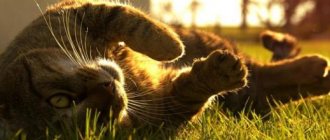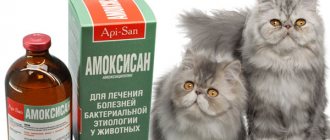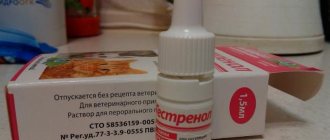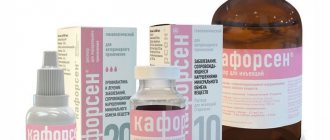Medicinal properties and indications for use
In practice, Vermox demonstrates high effectiveness in the presence of pinworms. But it also works when affected by some flatworms (tapeworms) and nematodes.
The active substance enters the systemic bloodstream of the animal in small quantities.
The main effect is manifested in the gastrointestinal tract and liver.
The active component of the drug is removed with feces and urine.
Indications for use
Vermox has performed well in the treatment of mixed helminthiases.
But it can be used successfully for mono-infection:
- roundworms (ascariasis);
- pinworms (enterobiasis);
- pork tapeworm (taeniasis);
- hookworms (hookworm);
- whipworm (trichocephalosis);
- intestinal acne (strongyloidiasis);
- gnastomases (gnathostomiasis);
- trichinella (trichinosis);
- alveococcus (alveococcosis);
- echinococci (Echinococcosis).
Many veterinarians believe that after treatment with Vermox, a dog or cat should be given laxatives to remove dead parasites from the intestines.
A special feature of the drug is the possibility of its deposition in adipose tissue. Therefore, constant use to remove worms from dense pets can cause its accumulation in their body.
Directions for use and dosage (for cats and dogs)
Vermox tastes very unpleasant (bitter).
But you can only give it to an animal per os (through the mouth).
- For dogs, the tablet is usually crushed and mixed with minced meat; it is advisable to make small balls with the medicine inside so that the pet can swallow them whole. The product is used for dogs in a minimum dose of 50 mg, the dosage is calculated depending on the weight of the pet - 22 mg/kg. The dose must be determined by a veterinarian.
- For cats, the tablet is crushed and mixed with 8 cubes of water. Then take 1 cube and pour it into the cat.
Give pets the drug for 3 days in a row, once a day. You can repeat the deworming course no earlier than in a month.
Side effects
Usually, with the correct dosage of the Vermox drug, side effects do not occur. However, the main symptom of drug intolerance is severe vomiting. If such a symptom appears, it is necessary to perform a gastric lavage on the cat and, as soon as possible, take the animal to a veterinary clinic.
Important! Vermox is used to treat cats only when absolutely necessary, carefully, under the supervision of a doctor, so as not to harm the animal. You cannot replace “Vermox” with a similar drug, “Dekaris”. It is life-threatening for cats.
READ Wheezing in chickens: how to treat coughing in chickens
Contraindications and characteristics of the active substance
The use of Vermox as a preventative is not recommended if the animal walks outside on its own. Although in medical practice (in humans) the drug is used for these purposes.
Do not give medicine to an animal if it:
- changed color;
- has foreign inclusions;
- crumbled;
- expiration date has expired.
Veterinarians strongly discourage the use of medicines for the treatment of helminthiases in animals:
- young age (puppy up to 6 months, kittens up to 1 year);
- in addition to helminthiasis, those suffering from any infectious diseases;
- weakened;
- exhausted;
- pregnant women;
- with immunodeficiency;
- with pathology of the liver and kidneys;
- with ulcerative lesions of the intestine;
- individual intolerance to the components of the product by the animal’s body or if there is an allergy to it.
You should refrain from administering Vermox to an animal if it is angry. You cannot overdose the drug. This can cause multiple organ failure and coma of the animal.
In case of an overdose of medication in an animal:
- vomiting with foam begins;
- diarrhea (profuse);
- thirst;
- polyuria;
- apathy.
If 1 or more symptoms appear, Vermox is discontinued and the animal is taken to a veterinarian for consultation.
Analogs
Complete analogues (synonyms) of the drug are:
Of the veterinary medications, Milbemax is now especially popular.
The variety of modern drugs against helminth infections in veterinary medicine is amazing. There are hundreds of items, and the pharmaceutical industry is constantly producing new ones! But sometimes it happens (in remote settlements where there are no veterinary pharmacies) that you have to use the range of ordinary, “human” hospitals. There you can find the drug Vermox, originally intended to destroy worms in the human body.
Characteristics of the drug
This is the name of the medicine for the treatment of ascariasis. Let’s immediately make a reservation that you can give it to cats only as a last resort, when there are no alternatives at all! There are many purely veterinary drugs created specifically for animals, the effect of which on cats has long been studied and described. It’s not worth taking risks unless absolutely necessary!
The active substance is mebendazone. The mechanism of action is based on disruption of the synthesis of tubulin in helminth cells. In addition, the drug prevents the formation and destroys existing ATP reserves, which deprives parasite cells of energy and leads to their death. Antihelminthic drugs based on mebendazone have enough advantages: they are very slowly (within five to ten hours) absorbed from the gastrointestinal tract, about 10% of the total dose enters the blood (on average 5-7%). More than 90% of the drug remains unchanged in the feces, so helminths have a hard time.
The medicine is available in tablet form. The pills look white, each of them is divided into two equal halves by a deep score. Packaged in blisters made of food grade plastic and aluminum foil. Packed in cardboard boxes indicating the name, release date, batch and expiration date. One package contains one blister with six tablets. It is strictly prohibited to give expired medication, as well as pills that have changed their color, with foreign impurities, or moistened, to a cat (and to people too).
Description of the drug
"Vermox" is a drug intended for the treatment of ascariasis.
The drug is not a veterinary medicine and therefore cats can only be treated with it in exceptional cases. There is no need to use it to prevent diseases. There is no need to risk your pet's health unnecessarily.
The main active ingredient is mebendazone. Its job is to suppress the production of tubulin in parasite cells. Also, the drug reduces the synthesis and eliminates accumulated reserves of adenosine triphosphoric acid, which leaves helminth cells without energy and causes their death.
© shutterstock
Anthelmintic medications, including mebendazone as the main component, have a number of advantages: when passing through the gastrointestinal tract, they are absorbed extremely slowly, only about 10%. So the drug, in almost unchanged form, enters the feces, killing parasites.
Vermox is produced in tablet form. Externally, they are white in color and have a double-sided deep diametric notch dividing the tablet into two halves. Packaging is done in blisters of 6 pieces. Each blister comes in a separate cardboard box, complete with instructions for use. The date of release of the drug and the period before which it must be used are indicated on the packaging.
Medicine that has expired, has been soiled, or contains tablets that have changed color cannot be used to treat a cat (and neither can a person).
Notes and contraindications
It should be noted that mebendazone has a specific feature - it accumulates in adipose tissue. Because of this, “chubby” cats cannot often be fed with Vermox, since a cumulative effect and an accompanying overdose are very likely. For the same reason, it is strictly forbidden to prescribe medicine to those animals for which there is even the slightest suspicion of the development of lipidosis (obesity) of the liver or kidneys . The medicine is excreted in the feces, small doses are excreted in the urine.
In addition, it is prohibited to give Vermox to cats of the following “categories”:
- Weak and old cats.
- Pregnant and lactating cats.
- Young animals under the age of one year. Many veterinary drugs against helminths can be given to kittens from two to three months, but not in this case. So, even for children, Vermox is prescribed only from the age of two and only under the supervision of a pediatrician.
- Do not give the drug to sick pets. It is unknown how the cat’s already weakened body will react to it.
In addition, even if your pet is healthy (except for worms), old enough and reasonably well-fed, you need to watch him very carefully after giving Vermox.
The following side effects are possible:
- Apathy, if the animal had any problems with the liver, a lethargic state may develop.
- Seizures similar to epilepsy: convulsions, foam at the mouth, and simple vomiting.
- Profuse diarrhea.
- Increased thirst , the animal can gurgle and slurp to drink a whole bowl of water in one sitting, polyuria.
- Inappropriate behavior.
Attention! At the slightest overdose, the cat begins to vomit a foamy mass. In this case, as well as if you observe at least one of the above symptoms, call a veterinarian immediately!
How to get rid of worms without risk to your pet
To protect yourself and your pet, you need to remember the following:
- Only clinically healthy animals are anthelmintic (if there is a digestive disorder - vomiting, loose stools, refusal to feed, then giving an anthelmintic is prohibited until an appointment or consultation with a veterinarian);
- Prevention of worms in dogs and cats is carried out once every 3 months;
- Preventive treatment of puppies and kittens is carried out for the first time at 3 weeks or 1 month, then before the first vaccination it is mandatory (vaccination is carried out from 2 months, respectively, the anthelmintic should be given 10 days before it), if there are no worms after deworming, it is carried out vaccination, if any, requires repeated treatment at intervals and only then, the first vaccine in life. Next, before revaccination at 3 months (again, the drug is given 10 days before), if the first vaccine was given earlier than prescribed, and at the time of revaccination the puppy/kitten is not yet 3 months old, then we revaccinate without rabies and without deworming, and then, when 3 months arrive, we vaccinate purely against rabies (give an anthelmintic 10 days before). Subsequently, anthelmintic is administered once every 3 months and 10 days before the annual vaccination;
- All animals in the house are dewormed at the same time;
- It is not recommended to anthelmintize pregnant and lactating females unless absolutely necessary, so giving an anthelmintic should be done 10-14 days before mating;
- After your pet comes into contact with animals infected or potentially infected with helminthic infestation, preventive deworming is required;
- If you notice eggs in the stool that look like grains of rice, small worms or something similar, carry out preventive deworming;
- The administration of drugs is carried out strictly by weight: if you give a smaller amount of the drug, it will not have a full effect, and an overdose can harm the animal’s body;
- Try to use only high-quality imported drugs. Since imported products undergo more degrees of control and testing, they produce fewer side effects, are tolerated more gently by the body, but at the same time retain their high effectiveness.
It is important to remember that if the fact of helminthic infestation is established, and this can be done by passing a stool test (scatology) or visually noticing worm eggs in the feces, then deworming should be carried out 2 times with an interval of 10-14 days. This is due to the fact that after the first administration of the drug, adults die and emerge; repeated administration of the drug is required to remove the larvae and eggs of the parasite. Most often, giving the drug twice is sufficient, but there may be cases that require taking the drug more times.
Since worms in the process of life activity emit a certain amount of toxins, and this amount, in most cases, does not visually change the condition of the animal in any way, then with severe helminthiasis after giving an anthelmintic drug, the parasites die simultaneously and release a huge amount of these toxins, which can cause serious intoxication, causing vomiting, diarrhea, lethargy, apathy, and can even lead to the death of the animal. Therefore, after giving an anthelmintic, it is necessary to monitor the well-being of your pet: if the condition worsens, immediately consult a veterinarian.
You also need to take into account the fact that helminthiasis belongs to anthropozoonoses - a group of infectious and invasive diseases common to animals and humans.
For this reason, there is a danger of infection of the animal owner and all family members. To avoid the unpleasant consequences of helminthic infestation, it is necessary to protect your body prophylactically.
Dose and method of administration
The medicine is prescribed exclusively internally. What is the dosage of Vermox for cats? For a medium-sized cat, exactly 1/8 of the tablet is needed. In order not to “bother” with dividing the pill into eight tiny parts, you should do this: take a tablet, crush it to a powder, and dilute it in 8 ml. water. After thorough shaking, exactly a milliliter is drawn out with a syringe and given to the cat. Of course, 7/8 of the medicine goes to waste, but still the cat’s health is more expensive.
Vermox for animals is bitter, so you will have to force-feed it to your pet.
The medicine should be given half an hour before meals, twice a day. By the way, the dissolved dose of the drug can be used twice, but the product must be stored in the refrigerator. Frequency of application: three days in a row. After a month, the course of treatment must be repeated, but whenever possible it is better to use normal veterinary medications. Fortunately, there is now not even a remote shortage in their assortment.
Reception scheme
This medicine should be given to a dog or cat strictly following certain dosages:
- For dogs, the dosage is 22 mg of the active substance of the drug per 1 kg of the pet’s body weight;
- For cats, the dosage is different - one tablet is crushed into powder and filled with 8 ml of water, then 1 ml of this suspension is given to the pet.
For dogs, the medicine is given twice a day half an hour before meals (the dose indicated above is not divided into two doses, but is taken twice). To avoid problems with feeding the medicine, the tablets can be mixed with minced meat (a small amount), hidden in a piece of sausage, etc.
It is important to ensure that the animal does not chew the tablet, as it is bitter and there is a high probability that saliva will flow from the dog’s mouth and the tablet will not enter the stomach.
Giving medicine to a cat is easier, since in a liquid state it can be poured onto the root of the animal’s tongue directly from a syringe. The medicine is given twice a day half an hour before meals. Instructions for taking the medicine for cats suggest a course lasting three days.
Since this drug is not intended for animals, there are a number of cases in which it is prohibited to give Vermox to an animal.
- It is not given to pregnant or lactating females;
- It should not be given to a kitten under one year of age;
- Not allowed for puppies under six months of age;
- For infectious diseases, any anthelmintic therapy is prohibited;
- If the animal is angry, exhausted or has an immunodeficiency state, it cannot be used;
- Kidney and liver diseases are the main and most serious contraindication, since failure to comply with this can result in death for the patient.
It is important to strictly adhere to the dosage of the drug and, at the slightest confusion, consult a doctor. It is better to use this remedy strictly on the recommendation of a doctor and under his supervision.
Efficiency and principle of influence
Due to the fact that Vermox is a drug for treating people, it is given to a dog or cat in the absence of alternative options. In this case, it is necessary to strictly calculate the dosage and coordinate it with the veterinarian. If it is impossible to seek veterinary help, then it is necessary to choose medications produced for dogs or cats. Vermox for animals is less safe and effective than specific medications. It has a good effect not only on roundworms, but on a large number of their species, which allows it to be used effectively for mixed infestations, which are often found in domestic pets.
Vermox for dogs and cats
The dosage of Vermox for cats, as well as for dogs, is very important. If it is calculated correctly, then the effectiveness of the drug is very high. The medicine affects not only mature helminths, but also their larval form and even eggs. By acting on parasites, the medicine causes paralysis of smooth muscle fibers, which leads to helminths detaching from the intestinal lining of the cat or dog. In addition to the above, the drug inhibits the absorption reactions of nutrients, which provokes the death of worms. Vermox dissolves the shell of parasite eggs, and inhibits the development of larvae and prevents their transformation into mature worms capable of reproduction.
Analogues of the drug
For people who have individual contraindications to the active components of the drug Vermox, the doctor prescribes an analogue remedy to combat helminths. Analogs may contain other components, have different names, but perform the same function in treating diseases.
The most effective analogues of Vermox are as follows:
There are cases when a previously prescribed drug did not suit the patient, and the disease was not completely eradicated. In this case, the doctor prescribes a more suitable analogue drug to combat parasites.
Every year, pharmacists create many new drugs, including those against parasites. One of the most popular drugs is Vermox.
This product has a wide range of effects. After taking the tablets, the worms leave the body as soon as possible.
Before using the drug, it is important to know what worms it helps against and how it works. You need to take the medicine if you have the following types of helminthiasis:
- Ascariasis,
- Enterobiasis,
- Strongyloidiasis,
- Trichocephalosis,
- Trichinosis,
- Mixed types of helminthiasis,
- Capillariasis.
These deworming tablets are considered very effective because the worms leave the body very quickly. Before starting treatment, you should decide what dosage is needed.
The drug Vermox affects worms so that they die in the intestines within a couple of days after consumption. This is done due to the special property of the drug to disrupt the metabolism of helminths. Over time, the worms simply die from exhaustion and leave the human body along with feces.
Different types of worms can leave the body in several ways. For example, one type of helminth can be completely digested in the intestines, and a person will not see them in the feces. The other type is only partially destroyed. There are also worms that come out in the form of small white threads.
Vermox can act thanks to its main substance - mebendazole, of which each tablet contains 100 mg. Mebendazole effectively fights tapeworms and roundworms.
One of the most common worms is the pinworm, which causes enterobiasis. Vermox is also prescribed for helminthiasis:
If worms are suspected, people often self-medicate, which is contraindicated. You should follow the instructions for the drug, since Vermox does not kill all types of worms.
If the dosage is determined correctly, you should still take into account some of the nuances that the doctor performs. Vermox, like any anthelmintic drug, is quite toxic.
The active component is 90% excreted from the intestines in unchanged form. Approximately 10% of the substance enters the liver and is excreted by the kidneys.
Prescribing the medication is justified if helminths are identified, as laboratory tests have been carried out. You should have your stool and smear tested for enterobiasis.
Unlike other worms, pinworms lay eggs outside the intestines. Even if they are in the body, these eggs are not present in the stool analysis.
To identify ordinary worms, you need to submit a stool sample to a laboratory, but the case with pinworms is somewhat more complicated. The study should be carried out immediately after taking a scraping; in extreme cases, the material should be delivered to the laboratory within two hours. In this case, a test for worms is taken before all hygiene procedures are completed.
Instructions for use
The canine dose of the medication is 22 mg of the active ingredient per kilogram of the animal’s body weight. This means that the dosage per 10 kg dog will be 220 mg. This is a single dose. It is recommended to give the medicine to your pet twice a day, 30 minutes before meals. Vermox can be given to a dog by mixing it with minced meat or dissolving it in water as a suspension. A good way is to wrap the entire tablet in a small amount of minced meat and form a small ball that the dog can swallow without chewing.
A chewed tablet, due to its strong bitterness, will provoke intense salivation and will not completely enter the pet’s body.
The drug must be given to the cat in the form of a homemade suspension. The tablet is crushed to a powder and mixed with water in an amount of 8 ml. A single dose is 1 ml of the prepared suspension. The drug is given morning and evening for three days. The food is given to the animal half an hour after taking the medicine. The product is poured from a syringe into the area of the root of the tongue. This simplifies the process compared to the above for a dog.
Application
It is forbidden to drink alcohol within 24 hours after taking the drug, as it has a prolonged effect. Also during this period you should not eat fatty foods and sweets. No other diet or food restrictions are required. They are also not needed before taking the product.
The medicine is quite toxic, so regular and close monitoring of the patient’s liver condition plays an important role in treatment. Treatment should be carried out under the supervision of a physician, especially long-term and with severe infestations.
For children
There are some differences in how to take Vermox for children, depending on what kind of invasion has affected the body. Also, the dosage of the drug is calculated depending on the degree of development of the invasion, the age of the child, his weight and other factors.
- Enterobiasis. At the age of 2 to 5 years, a quarter of a tablet is prescribed once, and the same dosage of the drug is repeated two weeks later, and then after another two weeks. At the age of 5 to 10 years, you can give a child half a tablet, otherwise the scheme is the same as in the previous case. Over the age of 10 years, a child can be treated as an adult, that is, prescribed 1 tablet once, with a repeat dose two weeks and a month after the first dose;
- Other types of invasions. Course duration is 3 days. Take one tablet daily, preferably in the morning. You need to drink a small amount of water.
The description of the drug confirms that this is a non-hazardous drug. Therefore, it is better if, when an infestation is detected in one of the family members, everyone who lives with him under the same roof undergoes anthelmintic therapy. This is recommended because the invasion is easily transmitted and can remain asymptomatic for a long time.
For adults
Below are some tips on how to take Vermox for adults:
- Enterobiasis. You need to take one tablet with a dosage of the active substance of 150 mg once, the entire dose at one time. Repeat the course after 2-4 weeks (at the doctor’s discretion) to avoid re-development of the invasion;
- Ascariasis. For this disease, the drug is taken in a short course over three days, one 150 mg tablet during or after meals in the morning and before or during meals in the evening;
- Teniosis, mixed invasions. The same as in the case of ascariasis;
- Trichocephalosis. Take 400 mg three times a day for the first three days of treatment, and then from days 4 to 10 of treatment - 5 tablets 3 times a day.
If an adult is prescribed a long course of taking the drug, then treatment should be carried out strictly under the supervision of a doctor. Monitoring the condition of the liver is important.
For prevention
Prevention of worms with this remedy is also quite simple. The dosage for prevention is the same as for treatment. The drug should be used once. It is better to carry out prevention in the autumn and spring. It should be carried out at least twice a year, but not more than four.
Prevention is needed by people working in children's institutions, as well as those who interact with stray animals. Owners of outdoor pets are also at risk. Children should undergo preventive measures regularly, since it is in children's groups that such infestations spread especially actively.
During pregnancy
The drug is contraindicated for pregnant women due to the fact that insufficient research has been conducted on this matter. It is known for sure that the drug cannot be used in the early stages, as it can negatively affect the development of fetal systems and organs. At later stages, its effect on the fetus has not been studied, but it is partially absorbed into the blood and penetrates the placenta, which means a negative effect cannot be excluded.
In addition, Vermox when planning pregnancy may also have some effect on the results. A common side effect of taking it is a decrease in hemoglobin and red blood cells in the blood, and anemia may develop. Such changes in tests may cause a slight delay in pregnancy until the tests normalize (at the discretion of the specialist).
Side Effects
Usually the correct dose of the drug does not cause adverse side effects in a cat or dog. If Vermox is poorly tolerated, then the first thing that the animal will develop is intense vomiting. As soon as this symptom appears, you must immediately contact a veterinarian. Before transporting the animal to the clinic, it is recommended to arrange for the pet to perform independent gastric lavage.
When intolerance manifests itself in a mild form, the cat or dog is bothered by loose stools, which can be expressed in both moderate and intense forms. If stool disorder is observed in a mild form, then it is recommended to use symptomatic correction of the condition.
Side effects of Vermox in animals
If you notice signs that your pet is not tolerating treatment well, you must immediately stop taking the drug. You should consult your veterinarian regarding the possibility of using the medication in the future.
Side effects
With normal dosage, side effects usually do not develop. However, the first sign of poor tolerability of the drug or overdose is severe vomiting. If this effect occurs, you should immediately contact a veterinarian and rinse the animal’s stomach yourself before it is delivered to the veterinary clinic.
Sometimes, with mild intolerance, diarrhea develops, moderate or quite severe. For mild diarrhea, symptomatic treatment can be provided. At the first sign of poor tolerability of the drug, you should immediately stop taking it. The question of whether mebendazole preparations can be given in the future should be checked with your veterinarian, as sometimes veterinary preparations with the same substance can be tolerated normally.
When treating a puppy older than six months, you can start taking it with reduced dosages, which will help you understand how the animal tolerates the drug.
Contraindications
Vermox has an impressive list of contraindications due to its unsuitability for veterinary use. The drug is prohibited for cats under one year old, pregnant and lactating females. Dogs should not be used until six months of age. It is forbidden to give the remedy to embittered or exhausted animals, dogs and cats suffering from infectious diseases or pathology of the kidneys, liver cell functions. If you give Vermox tablets to a pet with a diseased liver or kidney failure, it can cause the death of the dog or cat.
Reviews
One day I went with my cat to visit relatives in the village. There I was cleaning the tray as usual and suddenly noticed worms in it. I didn’t want to wait for treatment, nor did I want to interrupt the trip, but there were no veterinary pharmacies or pet stores nearby. Relatives had Vermox tablets in their medicine cabinet. I called our veterinarian and explained the situation. He told how to make a suspension for a cat from this medicine. I did everything and treated my pet according to the doctor’s recommendations. When we returned, we went to the clinic for examination and were happy to find out that everything was fine.
I once had the opportunity to use Vermox to treat my dog. He managed to deceive Gray by wrapping the tablet in minced meat. There were no particular side effects, only a slight loosening of the stool, which quickly passed as soon as the treatment was completed. But I didn’t use this medication anymore. The veterinarian said that for your pets it is better to use those tablets that are created specifically for them. This is not only more effective, but also safer.
Can Vermox be given to a cat?
Efficiency and principle of influence
Due to the fact that Vermox is a drug for treating people, it is given to a dog or cat in the absence of alternative options. In this case, it is necessary to strictly calculate the dosage and coordinate it with the veterinarian. If it is impossible to seek veterinary help, then it is necessary to choose medications produced for dogs or cats. Vermox for animals is less safe and effective than specific medications. It has a good effect not only on roundworms, but on a large number of their species, which allows it to be used effectively for mixed infestations, which are often found in domestic pets.
Vermox for dogs and cats
The dosage of Vermox for cats, as well as for dogs, is very important. If it is calculated correctly, then the effectiveness of the drug is very high. The medicine affects not only mature helminths, but also their larval form and even eggs. By acting on parasites, the medicine causes paralysis of smooth muscle fibers, which leads to helminths detaching from the intestinal lining of the cat or dog. In addition to the above, the drug inhibits the absorption reactions of nutrients, which provokes the death of worms. Vermox dissolves the shell of parasite eggs, and inhibits the development of larvae and prevents their transformation into mature worms capable of reproduction.
Instructions for use
The canine dose of the medication is 22 mg of the active ingredient per kilogram of the animal’s body weight. This means that the dosage per 10 kg dog will be 220 mg. This is a single dose. It is recommended to give the medicine to your pet twice a day, 30 minutes before meals. Vermox can be given to a dog by mixing it with minced meat or dissolving it in water as a suspension. A good way is to wrap the entire tablet in a small amount of minced meat and form a small ball that the dog can swallow without chewing.
On a note!
A chewed tablet, due to its strong bitterness, will provoke intense salivation and will not completely enter the pet’s body.
Vermox for animals
The drug must be given to the cat in the form of a homemade suspension. The tablet is crushed to a powder and mixed with water in an amount of 8 ml. A single dose is 1 ml of the prepared suspension. The drug is given morning and evening for three days. The food is given to the animal half an hour after taking the medicine. The product is poured from a syringe into the area of the root of the tongue. This simplifies the process compared to the above for a dog.
Reviews
One day I went with my cat to visit relatives in the village. There I was cleaning the tray as usual and suddenly noticed worms in it. I didn’t want to wait for treatment, nor did I want to interrupt the trip, but there were no veterinary pharmacies or pet stores nearby. Relatives had Vermox tablets in their medicine cabinet. I called our veterinarian and explained the situation. He told how to make a suspension for a cat from this medicine. I did everything and treated my pet according to the doctor’s recommendations. When we returned, we went to the clinic for examination and were happy to find out that everything was fine.
Evgenia, Moscow
I once had the opportunity to use Vermox to treat my dog. He managed to deceive Gray by wrapping the tablet in minced meat. There were no particular side effects, only a slight loosening of the stool, which quickly passed as soon as the treatment was completed. But I didn’t use this medication anymore. The veterinarian said that for your pets it is better to use those tablets that are created specifically for them. This is not only more effective, but also safer.
Sergey, Belgorod
Vermox is an anthelmintic agent. The active ingredient of the drug is mebendazole. Mebendazole reduces glycogen reserves, prevents glucose utilization, inhibits ATP synthesis, and disrupts the formation of the protein tubulin, which is necessary for the construction of the body and vital activity of helminths.
90% of the drug combines with proteins in the blood and accumulates in the liver, fat cells, and helminths. The drug is excreted unchanged in the feces (90%). Part of mebendazole that has managed to be absorbed by the kidneys (5-10%).
After taking the product, veterinarians recommend giving a laxative, since Vermox itself does not cause a laxative effect. When accumulating a dose greater than the therapeutic one, side effects may occur.
Available in the form of tablets containing 100 mg mebendazone, in a blister - 6 tablets. The tablets are white and sometimes slightly yellowish in color.
The drug is effective against helminth infections caused by:
- Gnathostoma spinigerum (gnathostomiasis).
- Capillaria hepatica, philippiensis, aerophila (capillariasis).
- Echinococcus multilocularis (alveococcosis).
- Echinococcus granulosus (echinococcosis).
- Taenia solium (taeniasis).
- Trichinella spiralis (trichinosis).
- Trichocephalus trichiurus (trichocephalosis).
- Strongyloides stercoralis, procyonis, fuelleborni, myopotami (strongyloidiasis).
- Ancylostoma duodenale, dubini (hookworm).
- Ascaris lumbricoides (ascariasis).
- Enterobius sp (enterobiasis).
Can it be given to dogs?
Vermox is a drug made to treat helminthiases in humans. Accordingly, when developing this product, we were guided by the anatomical and physiological characteristics of the human body. Human clinical trials have been conducted for safety and efficacy.
Based on this, Vermox can of course be used by our smaller brothers, but only in situations where it is not possible to buy veterinary anthelmintic drugs. If side effects occur, you must immediately stop taking the drug and give the dog an enterosorbent (activated carbon, Tzamax, Enterosgel).
It is also possible to take Vermox if treatment with veterinary drugs is ineffective. Here, the therapeutic effect provided is given priority over possible side effects. It should be remembered that the drug is used exclusively for the treatment of helminthiases. If you need to choose a preventive remedy, then take a veterinary anthelmintic.
Situations that have an absolute contraindication to taking Vermox in dogs:
- Dogs under 6 months old.
- Pregnant and lactating. Mebendazole crosses the placental barrier and has a teratogenic effect on the fetus. Vermox accumulates in the milk of a nursing dog, causing a toxic effect on puppies.
- Severely malnourished dogs.
- Patients with an infectious disease.
- Dogs with liver and kidney problems. The liver is an organ that performs more than 20 important functions, including the neutralization of drugs (detoxification). In case of liver and kidney diseases, large doses of the drug accumulate, which is fraught with serious side effects, including coma and death.
Instructions for use of Mebendazole
Regardless of the form of release of the pharmaceutical product, each package of Mebendazole is accompanied by instructions for use, which indicate contraindications to the drug, possible side effects, dosage and symptoms of overdose. Therefore, before you start taking the described medication, you should read the instructions.
This medication is prescribed orally, once or twice a day, during or after meals. For enterobiasis, the dosage of the anthelmintic drug is 0.1 g, which should be taken at a time with a small amount of water.
If the risk of re-infection with worms is increased, then take the medication again after 2-4 weeks in the same dosage. For the treatment of ascariasis, it is recommended to take 100 mg tablets twice a day for 3 days.
Adults who have been diagnosed with taeniasis should take 0.2 g in the morning and before bed for 72 hours. To cure helminthosis from the group of nematodes, adults are prescribed 0.2-0.4 g three times a day for the first 3 days, and from the 4th to the 10th - 0.4-0.5 g in the morning , at lunchtime and in the evening.
If a disease has been identified that was caused by the larvae of the tapeworm Echinococcus, then the patient should take an anthelmintic medicine twice a day, 0.5 g for the first three days, and for the next 3 days in the same dosage, but three times a day.
Next, the medication is taken at a dose of 25-30 mg per kilogram of body weight three to four times a day.
The human body is very vulnerable to all kinds of parasites, including worms or, scientifically, helminths. The importance of worms is often underestimated by people; however, the consequences of infection with them are enormous for the health of people, especially children, who account for more than 80% of all helminthic infestations.
As a result of the introduction of parasites into the human body, a disease develops - helminthiasis.
- Composition of the drug "Helmintox"
- In what cases is it indicated to take the drug “Helmintox”, and in what cases is it prohibited?
- How does the drug work?
- Instructions for use
- Mode of application
- Adverse reactions
Vermox can be used to treat dogs only by giving it orally. No other uses are provided.
Dose – 22 mg. for every kilogram of live weight of the dog.
Give twice a day half an hour before meals. Since the average dog can take up to one and a half tablets, it is better to carefully “pack” them into small balls of minced meat and feed them to the animal.
The medicine is bitter, so the dog should not chew it. In the case of small or picky dogs, you will have to force the pills in.
In this case, it is better to grind them to a powder, dissolve them in water and pour them directly into the throat using a regular syringe. We warn you once again that the dosage of Vermox for dogs must be observed with high precision; we have already described the consequences of “overdoing it.”
Mebendazole is prescribed for the following diseases:
- helminthic infestation caused by pinworms;
- a parasitic disease caused by roundworms;
- hookworm disease;
- a disease caused by roundworms of the genus Strongyloides;
- helminthic infestation caused by whipworm;
- helminthiasis from the group of cestodoses, the causative agent of which is pork tapeworm.
A medicinal product containing the active component mebendazole is not recommended for persons who are hypersensitive to this medication. It is contraindicated to take anthelmintic tablets in children under 2 years of age, as well as in patients who have been diagnosed with ulcerative colitis.
Scope
Vermox is a human drug that can sometimes be given to a dog or cat. But for this it is necessary to carefully calculate all dosages and coordinate them with a veterinarian. To remove worms on your own, it is recommended that animals be given only specialized veterinary medications.
Why is Vermox prescribed for animals in some cases?
Usually, this only happens when, for some reason, it is not possible to purchase a specific veterinary drug. As such, there are no cases when giving Vermox to cats and dogs is preferable to a veterinary drug. Veterinary drugs are safer for animals and are also more effective against worms than those developed for humans.
Vermox works against several types of parasites, but only against roundworms. When infected with tapeworms, it is recommended to choose other drugs. However, the spectrum of action of this remedy includes many types of roundworms, and therefore it is indicated for multi-infestations that often occur in animals.
Reception scheme
This medicine should be given to a dog or cat strictly following certain dosages:
- For dogs, the dosage is 22 mg of the active substance of the drug per 1 kg of the pet’s body weight;
- For cats, the dosage is different - one tablet is crushed into powder and filled with 8 ml of water, then 1 ml of this suspension is given to the pet.
For dogs, the medicine is given twice a day half an hour before meals (the dose indicated above is not divided into two doses, but is taken twice). To avoid problems with feeding the medicine, the tablets can be mixed with minced meat (a small amount), hidden in a piece of sausage, etc. It is important to ensure that the animal does not chew the tablet, as it is bitter and there is a high probability that saliva will flow from the dog’s mouth , and the tablet will not enter the stomach.
Giving medicine to a cat is easier, since in a liquid state it can be poured onto the root of the animal’s tongue directly from a syringe. The medicine is given twice a day half an hour before meals. Instructions for taking the medicine for cats suggest a course lasting three days.
Since this drug is not intended for animals, there are a number of cases in which it is prohibited to give Vermox to an animal.
- It is not given to pregnant or lactating females;
- It should not be given to a kitten under one year of age;
- Not allowed for puppies under six months of age;
- For infectious diseases, any anthelmintic therapy is prohibited;
- If the animal is angry, exhausted or has an immunodeficiency state, it cannot be used;
- Kidney and liver diseases are the main and most serious contraindication, since failure to comply with this can result in death for the patient.
It is important to strictly adhere to the dosage of the drug and, at the slightest confusion, consult a doctor. It is better to use this remedy strictly on the recommendation of a doctor and under his supervision.
Useful materials:
- Cutaneous horn
General description of the disease Cutaneous horn on the forehead or face (ICD 10 code - L57.0) -... - Papillomas in dogs photo
How to notice papillomaIf the virus entered the body of a dog with good health and good living conditions,… - Staphylococcus in dogs
Treatment of staphylococcus Treatment of staphylococcus in dogs is carried out comprehensively. First of all, it is necessary to destroy the pathogen. For this… - Urinary incontinence in dogs
Causes of the condition When you suspect urinary incontinence, it would be best to refrain from punishing...
animalliberty.ru











